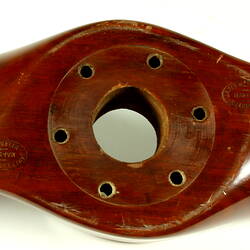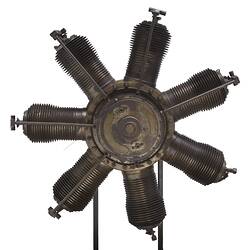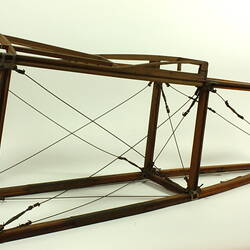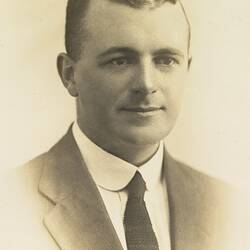Summary
Sculptured double-blade timber aircraft propeller fabricated from laminated Queensland-grown Circassian walnut wood (Juglans regia species) - also known as French walnut, Old English walnut, Persian walnut and Russian walnut. Manufactured by James Moore & Sons, timber merchants, of City Road, South Melbourne for Basil Watson, to be used with the Gnome 'Omega' 50 horsepower rotary aero engine on the Sopwith type single-seat biplane that he constructed in July-October 1916.
Basil Watson was introduced to flying by Harry Hawker during an Australian publicity tour in early 1914, and subsequently travelled to England with Hawker, where he undertook flying lessons and worked as an engineer with the Sopwith Aviation Company. After the outbreak of WWI he was seconded to the British Government as a military test pilot, based at Brooklands aerodrome. He was severely injured in a crash after suffering an engine failure on take-off during a test flight in June 1915, and returned to Australia 12 months later, after being declared medically unfit for further military service. After constructing his own biplane from scratch at his parent's home in Elsternwick, in little more than 3 months, Watson piloted the aircraft on pioneering flights to Bendigo, western Victoria and Mount Gambier. He performed the first public aerial acrobatics flying demonstrations for crowds of spectators in Melbourne and country towns, and flew the first official airmail between Mt Gambier and Melbourne in February 1917. He was killed on 28th March 1917 when his aircraft crashed in shallow water in Port Phillip Bay, after a structural failure occurred as he performed an aerobatics display over Point Cook, Victoria. His death was the earliest recorded aviation fatality in Australia.
Presented to the Museum in 1919 by James Isaac Watson, father of Basil Watson, together with the Gnome aero engine and other items salvaged from the wreckage of the crashed aircraft. Because the original propeller was reported to have been smashed during the crash, this propeller is believed to have been a spare.
Physical Description
Laminated walnut timber propeller, with 8 ft (2438 mm) long blade and sculptured right-hand twist. The propeller is polished and finished with varnish.
More Information
-
Collection Names
-
Collecting Areas
-
Acquisition Information
Donation from James I. Watson, 28 Oct 1919
-
Maker
James Moore & Sons, South Melbourne, Greater Melbourne, Victoria, Australia, 1916
-
Past Owner
Mr Basil G. Watson, Melbourne, Greater Melbourne, Victoria, Australia, 1916
-
Inscriptions
Impress stamped: 'JAMES MOORE & SONS - MAKERS - MELBOURNE' inside a small ellipical border near hub of propeller.
-
Classification
-
Category
-
Discipline
-
Type of item
-
Dimensions
2438 mm (Length)
-
Keywords
Aeroplane Components, Aircraft, Aircraft Propellers, Aircraft Manufacture, Aviation, Aviation Pioneers, Biplanes










